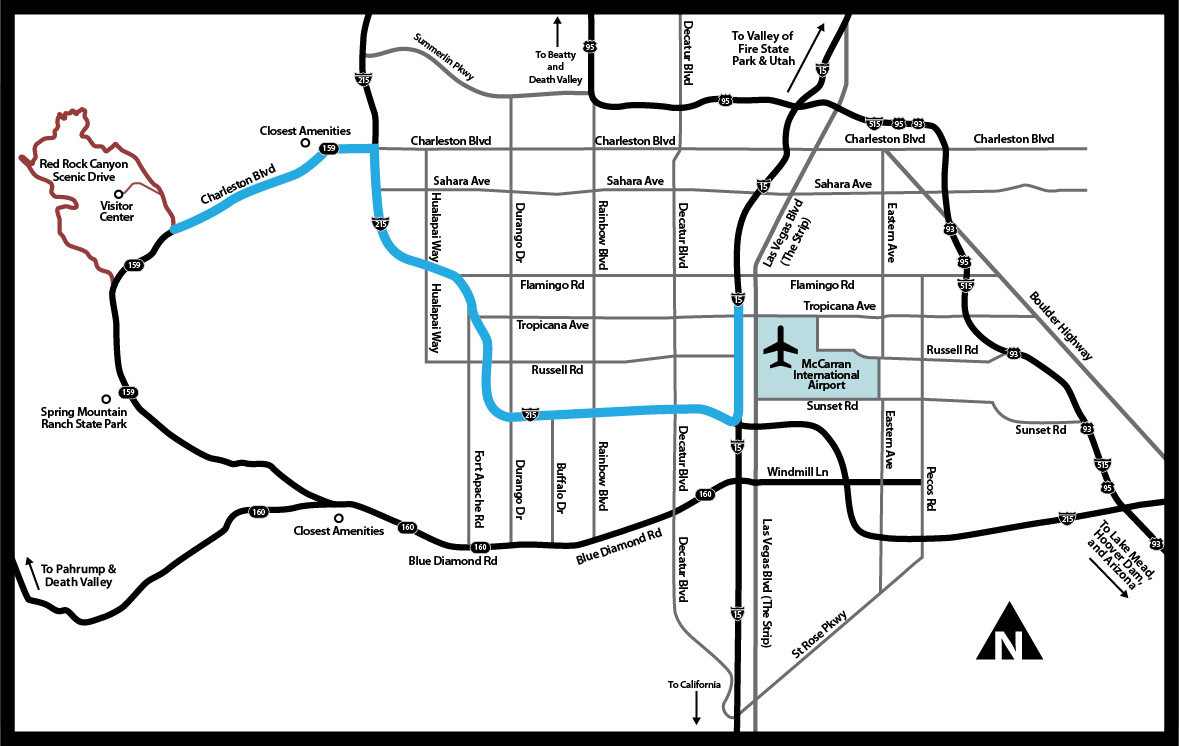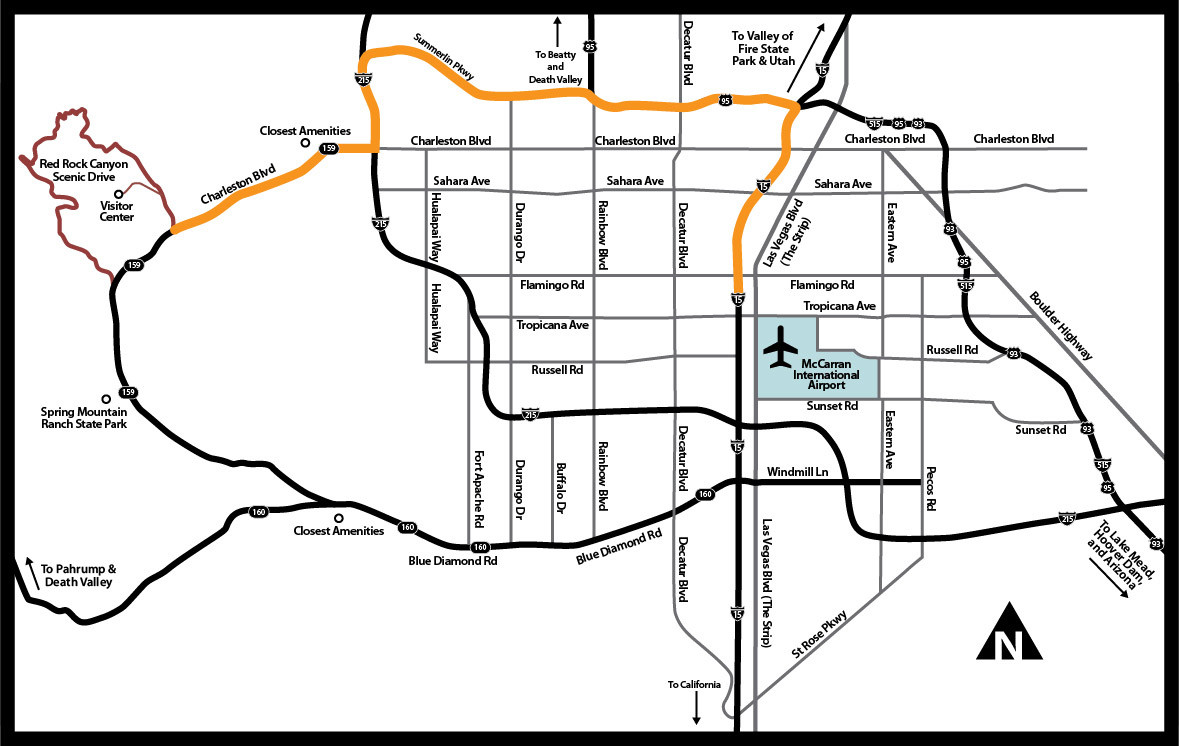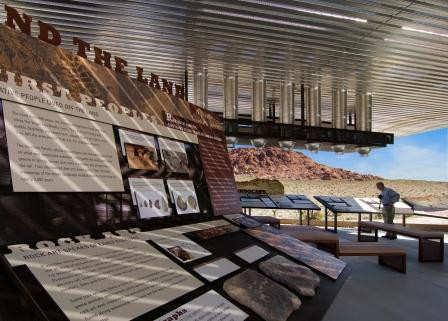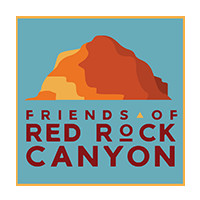Red Rock Canyon National Conservation Area, a stunning natural wonder, is a must-visit destination for nature lovers and adventure seekers alike. Just a short drive from the bustling Las Vegas Strip, this breathtaking landscape offers a dramatic contrast to the city’s bright lights and casinos. Whether you’re planning a day trip or a longer exploration, understanding how to get there, what to expect, and how to make the most of your visit is key. This comprehensive guide provides all the essential information you need to plan your trip to Red Rock Canyon National Conservation Area, ensuring a memorable and enriching experience.
Getting to Red Rock Canyon National Conservation Area: Directions and Transportation
Navigating to Red Rock Canyon National Conservation Area is straightforward, whether you’re driving yourself or relying on transportation services. Here’s a detailed breakdown of driving directions from different starting points in Las Vegas, along with information on public transport and tour options.
Driving from the Las Vegas Strip
For those driving, Red Rock Canyon is conveniently located just about 30 minutes from the Las Vegas Strip. For GPS navigation, it’s best to input “Red Rock Canyon Visitor Center” or the specific address: 3205 State Highway 159, Las Vegas, NV 89161.
From the Las Vegas Strip (South of Russell Road):
- Begin by getting onto I-15 South.
- Take Exit 36 for Russell Road/215 West.
- Keep left at the fork, following the signs for Interstate 15 South.
- Stay right at the fork to follow signs for 215 West and merge onto 215 West for approximately 13.5 miles.
- Take Exit 26 for Charleston Boulevard and turn left.
- Continue onto State Route 159/West Charleston Boulevard for about 5.5 miles.
- Finally, turn right into the entrance of Red Rock Canyon National Conservation Area.
 Driving Directions to Red Rock Canyon from South of Russell Road
Driving Directions to Red Rock Canyon from South of Russell Road
From the Las Vegas Strip (North of Russell Road):
- Start by heading onto I-15 North.
- Take Exit 42A to merge onto US-95 North toward Reno for around 6.8 miles.
- Take Exit 81A toward Summerlin Parkway and drive west for about 6.5 miles.
- The freeway will end; exit right to get onto 215 South for approximately 3.5 miles.
- Take Exit 26 for Charleston Boulevard/State Route 159 for about 5.5 miles.
- Turn right into the entrance of Red Rock Canyon National Conservation Area.
 Driving Directions to Red Rock Canyon from North of Russell Road
Driving Directions to Red Rock Canyon from North of Russell Road
From State Route 160:
- Get onto I-15.
- Take Exit 33 toward State Route 160 West/Blue Diamond Road.
- Keep right at the fork and merge onto State Route 160 West/Blue Diamond Road for about 10.5 miles.
- Turn right onto State Route 159 East/Charleston Boulevard (opposite the gas station) and drive for about 10.5 miles.
- Turn left into the entrance of Red Rock Canyon.
 Driving Directions to Red Rock Canyon from State Route 160
Driving Directions to Red Rock Canyon from State Route 160
Public Transportation and Tours
It’s important to note that public transportation does not directly serve Red Rock Canyon National Conservation Area. However, if you prefer not to drive, tour buses and commercial tours are readily available from most hotels in Las Vegas. These tours often provide convenient transportation and guided experiences, allowing you to relax and enjoy the scenery without worrying about navigation.
Exploring Red Rock Canyon National Conservation Area: Hours of Operation
Understanding the operating hours for different areas within Red Rock Canyon National Conservation Area is crucial for planning your visit, especially for the popular Scenic Drive.
13-Mile Scenic Drive
The iconic 13-Mile Scenic Drive within Red Rock Canyon requires timed entry reservations for entry between 8 a.m. and 5 p.m. from October 1st to May 31st. Reservations can be made at Recreation.gov or by calling (877) 444-6777.
| Month | Hours of Operation |
|---|---|
| November through February | 6 a.m. to 5 p.m. |
| March | 6 a.m. to 7 p.m. |
| April through September | 6 a.m. to 8 p.m. |
| October | 6 a.m. to 7 p.m. |
Special Note: The Scenic Drive operates from 6 a.m. to noon on Thanksgiving and Christmas Day.
Red Spring Picnic Area and Red Rock Overlook
These areas share the same operating hours throughout the year:
| Month | Hours of Operation |
|---|---|
| November through February | 6 a.m. to 5 p.m. |
| March | 6 a.m. to 7 p.m. |
| April through September | 6 a.m. to 8 p.m. |
| October | 6 a.m. to 7 p.m. |
Visitor Center and Administrative Office
The Visitor Center offers valuable information and exhibits, while the Administrative Office handles official inquiries.
| Area | Days | Hours of Operation |
|---|---|---|
| Visitor Center | Daily | 8 a.m. to 4:30 p.m. |
| Visitor Center | Thanksgiving Day | 8 a.m. to 12 p.m. |
| Visitor Center | Christmas Day | 8 a.m. to 12 p.m. |
| Administrative Office | Monday to Friday | 8 a.m. to 4.30 p.m. |
Red Rock Campground
The Red Rock Campground typically closes during the summer months, so it’s essential to check for seasonal closures if you plan to camp overnight.
Photography and Filming Permits at Red Rock Canyon National Conservation Area
Red Rock Canyon’s stunning scenery is a magnet for photographers. Understanding permit requirements for photography and filming is essential, especially for professional or commercial activities.
Casual Photography
Most visitors taking snapshots for personal use are considered casual users and do not require a film permit. This includes individuals or groups taking photos or videos for personal memories.
When is a Film Permit Required for Still Photography?
A film permit is necessary for still photography under the following conditions:
- Use of Models or Props: When using models or props that are not natural or cultural resources of the site. This includes professional portraits like wedding photos or product placements. Props include reflectors, sound booms, and similar equipment.
- Restricted Locations: If photography takes place in areas not generally accessible to the public.
- Additional Administrative Costs: If the photography is likely to incur additional administrative costs for the BLM.
Non-commercial still photography (e.g., landscape or wildlife photography) typically does not require a permit if none of the above conditions apply.
Permits for Moving Photography (Filming)
Moving photography, or filming, generally requires a permit, especially for commercial projects such as:
- Documentaries
- Television programs and feature films
- Advertisements
- Wildlife filming intended for commercial products
Student filming projects may be exempt from permits if they do not adversely impact public lands and are verified by an educational institution as a required project.
Obtaining Film/Photography Permits
Film and photography permits must be acquired in advance. For detailed information or to apply for a permit, contact the BLM via email at [email protected] or by phone at (702) 515-5381.
Special Recreation Permits (SRP) at Red Rock Canyon National Conservation Area
For organized activities and commercial uses within Red Rock Canyon National Conservation Area, Special Recreation Permits (SRPs) are often required. Understanding the SRP policy is crucial for event organizers and businesses.
SRP Pre-planning and Application Deadlines
First-time SRP applicants must schedule a pre-application coordination meeting with an Outdoor Recreation Planner, either in person or by phone, at least 30 days before submitting an application. This ensures complete applications and avoids delays.
SRP applications are accepted no earlier than one year and no later than 180 days before the proposed activity, unless waived by an Outdoor Recreation Planner under specific conditions.
Requirements for a Complete SRP Application
A complete SRP application includes:
- A filled-out Special Recreation Permit application form.
- A GPS-produced map of the proposed route or event site, compatible with BLM systems, or a pre-approved map.
- An Operating/Business Plan or other requested information.
- Advance payment of estimated fees (minimum $110).
Incomplete applications may be rejected outright.
SRP Fees
SRP fees vary based on the type of use:
- Commercial Use Fees: 3% of gross revenue or a minimum annual fee of $130, whichever is greater.
- Competitive Use Fees: $7 per person per day, 3% of gross revenue, or a minimum annual fee of $130, whichever is greater.
- Organized Use Fees: $7 per person per day or a minimum annual fee of $130, whichever is greater.
Additional site fees ($260) and exclusive use fees ($260) may also apply. Commercial businesses operating in the Conservation Area, regardless of size or fees charged, must obtain an SRP.
Cost Recovery and Limitations
If the BLM spends more than 50 staff hours processing and monitoring a commercial SRP in a year, cost recovery fees may be charged. This also applies to competitive or organized group uses if permit fees are less than processing costs. Cost recovery is limited to BLM’s costs for issuing, monitoring, and enforcing the permit, including environmental documentation and personnel time.
SRP Map and Operating Plan Requirements
Detailed maps and operating plans are critical components of the SRP application. Maps must be GPS-produced if using areas outside designated roads or trails. Operating plans should detail the proposed activity, emergency considerations, participant numbers, and mitigation plans.
Insurance and Other Requirements
Commercial and competitive SRP applicants, except vendors, must have liability insurance naming the U.S. Department of Interior-Bureau of Land Management as additionally insured. Minimum insurance requirements include property damage, personal injury, and annual aggregate limits. Applicants must also provide copies of related licenses and permits, such as Clark County Special Events Permits and business licenses.
SRP Stipulations and Reporting
Permittees must comply with SRP stipulations, including “Terms and Conditions” from the U.S. Fish and Wildlife Service, often related to protecting the Desert Tortoise. Reporting, including post-use reports and financial details, may be required to verify charges and compliance.
Bonding and Multi-year SRPs
BLM may require bonds to cover fees or restoration costs. Multi-year SRPs may be available for previously approved permits meeting specific conditions, at BLM’s discretion.
Limited Commercial Permits
Commercial permits for activities like bicycling, hiking, and rock climbing are limited. Waitlists may exist for permits that are currently at maximum capacity.
Visitor Center: Your Gateway to Red Rock Canyon National Conservation Area
A visit to the LEED gold-certified Visitor Center is highly recommended to enhance your experience at Red Rock Canyon National Conservation Area. It serves as an excellent starting point to gather information, learn about the area, and prepare for your explorations.
 Outdoor Display at Red Rock Canyon Visitor Center
Outdoor Display at Red Rock Canyon Visitor Center
Innovative Exhibits
The Visitor Center’s exhibits are primarily outdoors, focusing on four themes: earth, air, fire, and water. Explore the Earth exhibit to see desert tortoises and learn about geology, create a dust devil at the Air exhibit, discover agave roasting pits at the Fire exhibit, and appreciate water conservation at the Water exhibit. Indoor features include a staffed reception desk, Calico Hills views, interactive touch screens, a classroom, and a gift shop.
Evolution of the Visitor Center
The original visitor center, now the administrative building, opened in 1982 and served around 20,000 annual visitors. Today, with over a million visitors each year, the new, larger visitor center was built to enhance services and accommodate the growing number of people exploring Red Rock Canyon National Conservation Area.
Resources for Teachers, Parents, and Kids
Red Rock Canyon National Conservation Area offers numerous resources to engage learners of all ages, making it an ideal destination for educational visits and family outings.
For Teachers and Parents
Teacher Resources: This link provides educators with materials and information about Red Rock Canyon and general teaching aids.
For Kids
- Color Nevada Wild: A coloring book by the Nevada Department of Wildlife.
- Virtual Junior Ranger Red Rock Canyon: An activity book to learn about Red Rock Canyon and become a Junior Ranger.
- Jóvenes Guardabosques del Cañón Red Rock: The Junior Ranger program in Spanish.
- Junior Ranger Geology and Fossils: Activity book focused on geology and fossils.
- A range of other Junior Ranger activity books covering topics like wild horses, native plants, wildlife, wilderness, and citizen science are also available (links provided in the original article).
Volunteering at Red Rock Canyon National Conservation Area
Volunteering is a rewarding way to contribute to the preservation of Red Rock Canyon National Conservation Area. Individuals, families, and groups are encouraged to participate in various volunteer opportunities.
Benefits of Volunteering
Volunteers gain numerous benefits, including:
- Meeting like-minded people.
- Learning about the desert environment.
- Free training on geology, plants, animals, and native cultures.
- Enjoying the outdoors.
- Potential tax deductions for volunteer-related expenses.
Volunteer Opportunities
Various volunteer roles are available, such as:
- Information Desk assistance
- Tortoise Habitat Monitoring
- Trail Monitoring
- Natural Resource Team support
- Landscape Team assistance
For those interested in volunteering, contact the Volunteer Coordinator at (702) 515-5313.
Partnerships Enhancing Your Visit
Red Rock Canyon National Conservation Area collaborates with partner organizations to enrich visitor experiences.
Southern Nevada Conservancy
Southern Nevada Conservancy (SNC) enhances recreational, educational, and interpretive programs. SNC supports guided hikes, educational programs, off-site education, and the Elements Gift Shop. They also staff the fee station at the entrance.
Friends of Red Rock Canyon
Friends of Red Rock Canyon (FORCC) focuses on preservation, protection, and enrichment of Red Rock Canyon. FORCC assists with volunteer programs, graffiti removal, trail maintenance, and visitor center support. Fundraising efforts include the Dedication Walkway, license plates, and memberships.
 Friends of Red Rock Canyon Logo
Friends of Red Rock Canyon Logo
Contact Information for Red Rock Canyon National Conservation Area
For further inquiries, here are essential contact numbers and the mailing address:
Mailing Address:
Red Rock Canyon National Conservation Area
1000 Scenic Loop
Las Vegas, NV 89161-1202
Contact Numbers:
- Red Rock Canyon Main Information Line: 702-515-5350
- Emergency or Fire: 702-293-8932 or 911
- Hikes and Programs Sign-up: 702-515-5367
- Gift shop and Bookstore: 702-515-5379
- Scenic Drive Timed Entry, Campsites, and Group Picnic Area Reservations: 877-444-6777
- Commercial, Weddings, Large Groups Competitive Events, and Vending Permits: 702-515-5371
- Film and All Photography for Commercial Uses: 702-515-5399/5381
- Volunteer Coordinator: 702-515-5313
- Friends of Red Rock Canyon: 702-515-5360
- Southern Nevada Conservancy: 702-515-5367
- BLM Southern Nevada District Office: 702-515-5000
Red Rock Canyon National Conservation Area offers an unparalleled experience of natural beauty and outdoor adventure just minutes from Las Vegas. By planning your visit with this guide, you’ll be well-prepared to explore and appreciate this incredible landscape.